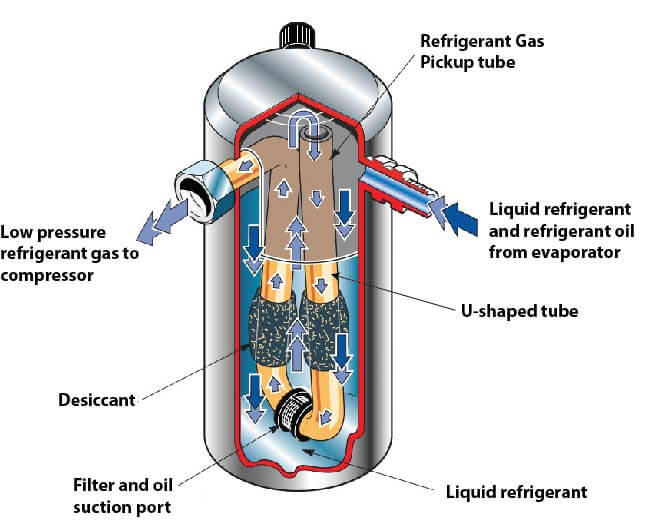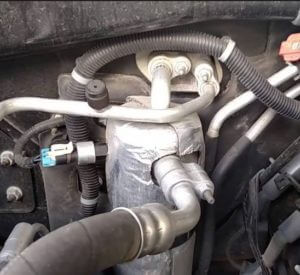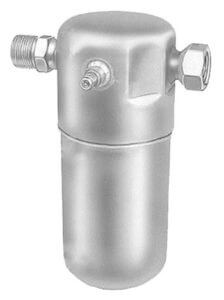Understanding the Role and Function of an AC Accumulator
Learn what an AC accumulator does and what happens when it fails
An auto air conditioning (AC) accumulator is a critical component in an orifice tube-style automotive AC system. The accumulator is typically found in the low-pressure side of the system, between the evaporator and the compressor. Its primary functions are to store excess refrigerant, filter out debris, and remove moisture from the refrigerant.
Why is an accumulator needed on an orifice tube-style AC system?
An orifice tube-style AC system isn’t as efficient or exact as a thermal expansion valve system. So it can allow too much refrigerant into the evaporator, causing some liquid refrigerant to flow out of the evaporator and into the compressor. The AC compressor is designed to compress vapor, not liquid, and liquid refrigerant entering the compressor can destroy it.
So, carmakers install an accumulator between the evaporator and the compressor to collect excess liquid refrigerant and prevent it from entering the compressor. As the excess liquid refrigerant sits in the accumulator, the surrounding engine heat causes it to vaporize and then flow into the compressor.
How an AC accumulator works
It stores liquid refrigerant so it can turn into a vapor
As liquid refrigerant and oil enter the accumulator inlet, they hit a baffle near the top that distributes the oil and liquid to the sides of the accumulator, where it falls to the bottom. A U-shaped tube is attached to the outlet of the accumulator.
The inlet to the U-shaped tube is located near the top of the accumulator, so it can’t suck any liquid refrigerant into the compressor. The tube contains an oil suction hole at the base. At the bottom of the accumulator, the liquid refrigerant contacts a bag of desiccant. The desiccant absorbs and stores any moisture that would contaminate the refrigerant. This moisture alters the chemical structure of the refrigerant and may freeze, corrode, or damage vital system components. When it’s saturated with moisture, the entire accumulator must be replaced. See the image below.

This image shows the flow of refrigerant into and out of the AC accumulator
It removes moisture from the system
Inside the accumulator is a desiccant bag that absorbs moisture from the refrigerant. Moisture in the AC system can freeze, causing blockages, or it can react with refrigerants to form corrosive acids, potentially damaging components.
The accumulator acts as a filter
The accumulator also contains a filter that traps debris and impurities in the refrigerant. This helps protect the AC system’s components from damage and prolongs the system’s lifespan.
It separates oil from the refrigerant
The accumulator helps separate the oil that circulates with the refrigerant and returns it to the compressor. This is crucial for lubricating the compressor and ensuring its longevity.
Where the AC accumulator located?
The AC accumulator is located on the outlet tube of the evaporator coil, usually in the engine compartment and near the firewall.

AC accumulator in the engine compartment near the firewall
The accumulator takes advantage of the engine compartment heat to boil the liquid refrigerant and turn it back into a gas so it can be compressed by the compressor.
How an accumulator fails
• The Desiccant Degrades: Over time, the desiccant inside the accumulator can become saturated with moisture and lose its effectiveness. This can lead to moisture buildup in the system, which can cause blockages, corrosion, or acid formation.
• Internal and External Corrosion: Accumulators are usually made of aluminum, which can corrode (oxidize) over time, especially if moisture or acids are present in the system. Corrosion can lead to leaks or restricted flow, impairing system performance. External oxidation can cause thinning and leaks.
• Clogging or Blockage: The filter or desiccant bag can become clogged with debris, reducing the accumulator’s ability to filter and protect the system. This can lead to decreased cooling performance or even system failure.
• Physical Damage: Accumulators can be damaged by impacts or other physical stresses, leading to leaks or loss of refrigerant.
• Oil Retention Issues: If the accumulator fails to separate and return the oil to the compressor properly, it can lead to insufficient lubrication and eventual compressor failure.
Symptoms of a Failing AC Accumulator
• Reduced Cooling Performance: A clogged or failing accumulator can restrict refrigerant flow, leading to reduced cooling efficiency.
• Unusual Noises: If liquid refrigerant reaches the compressor, it can cause knocking or other unusual noises.
• System Leaks: Corrosion or physical damage to the accumulator can lead to refrigerant leaks, resulting in a loss of cooling capacity.
• AC System Contamination: If the desiccant bag breaks down, it can release particles into the system, causing blockages or damage to other components.
• Compressor Damage: Without proper oil return, the compressor can become damaged due to lack of lubrication.
Why the shop wants to replace your accumulator
There are no moving parts in an AC accumulator.  But once an automotive AC system fails, debris and moisture can deposit in the accumulator. Also, if the AC system is open to the atmosphere due to a broken hose or leaking evaporator or condenser, the desiccant bag in the accumulator can soak up too much moisture, rendering it useless. Most compressor manufacturers’ warranty terms require the installation of a new accumulator any time the compressor is replaced. Failure to replace the accumulator can void your compressor warranty.
But once an automotive AC system fails, debris and moisture can deposit in the accumulator. Also, if the AC system is open to the atmosphere due to a broken hose or leaking evaporator or condenser, the desiccant bag in the accumulator can soak up too much moisture, rendering it useless. Most compressor manufacturers’ warranty terms require the installation of a new accumulator any time the compressor is replaced. Failure to replace the accumulator can void your compressor warranty.
©, 2018 Rick Muscoplat
Posted on by Rick Muscoplat
